Sunday, 18 July 2004
Leh, Jammu & Kashmir, India
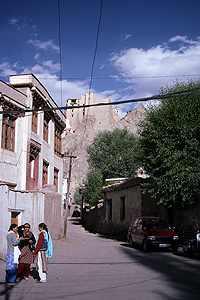
(Leh, Jammu & Kashmir, India)
We arrived at Delhi airport at 2300. We had debated for a long time whether to journey to Ladakh over land but had decided with only one safe route out of the region (the only other road goes through Srinagar) which takes three days each way, we would loose too much of our holiday if we did not take the plane in one direction. Since the next plane left at six in the morning this left us with a six hour wait at Delhi airport.
Delhi airport, whilst not spectacular, is relatively modern so was not the worst place to kill a few hours. We decided to hang out in a restaurant and it was here that I first noticed that there were several other westerners seemingly doing the same as us. About 0300 we jumped on an inter-terminal bus and went to the domestic terminal. Here we were met with quite a sight. Despite being now 0400 in the morning the place was packed out. What turned out to be a group from an English Girl's school occupied half the terminal and rather disconcertingly we realised that they, plus the majority of the remaining people in the terminal were going to Leh. I was under no illusion that the place was an undiscovered out post - after all Jet Airways runs two flights there every morning. However with the recent resurgence in the Kashmir Conflict and the murder of a German tourist, who witnessed some Muslims killing a Buddhist monk, in 2000 would have meant that its popularity as a destination was somewhat less than it clearly was.
Anyway after a lot more waiting we finally boarded the plane. To say the least it was the plane ride of a lifetime. It started out fairly uneventful, the mist of the plains blocking out all of our view. But suddenly the mist and the cloud parted and we started to make out the ridges and crests of the foothills of the Himalayas. Within a short time the low foothills gave way to sharp jagged peaks and behind these a high plateau which had been etched by the movements of huge glaciers. As we were flying very high above the mountains we had an incredible view.
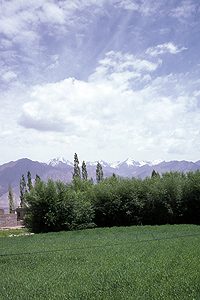
(Leh, Jammu & Kashmir, India)
Typically for me I did not bother getting my camera out, the fear of taking poor quality photos through the perspex windows putting me off. As we approach Leh I realised this was a huge mistake. Glacier fields gave way to narrow, sparsely cultivated river canyon. These were then punctuated by a range of purple and black mountains which looked wholly unnatural in the morning sun. Then as we approached Ladakh I saw a jaw dropping sight, a river gully coming down from the mountains had been used to irrigate an area of the lunar valley surface at the foot of the mountains. Literally its shape made it look like a green teardrop, and within this teardrop it was easy to make out individual fields which themselves were tear shaped and every conceivable shade of green. It was the sort of picture that made you dream that you could compile your own "Earth from the Air" book, if only you bothered to get your camera out in airplanes.
The landing was equally spectacular, the plane was forced to bank sharply left against the mountains above Leh and at one point was flying less than 50m above the tip of a spur of rock whilst the right wing tip was less than 10m away from another rocky outcrop. Even the touchdown was dramatic, since Leh Airport is one of the highest airports in the world, at 3256m (the highest being Bangda at 4334m in Tibet proper), the air is thinner thus it takes a lot more runway to land.
Outside the airport (well shed) we decided to ignore the various people hawking accommodation and catch a pre-paid taxi to a popular area for guest houses. However this approach caused all sorts of difficulties, we started walking around and asking for rooms but pretty soon it became clear that Leh was very busy and the altitude did not make the traipsing around easy. We probably walked around for an hour before we finally settled on a small guesthouse which had one of its approx ten rooms free. It was not the nicest room but it had a great view over the fields up to the Stupa which overlooks Leh so at 200 Rps (less than £3) a night it was not bad.
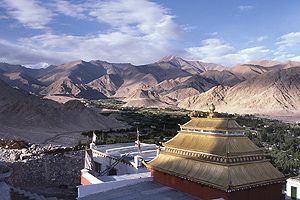
(Leh, Jammu & Kashmir, India)
We attempted to go for some lunch but the walking around at altitude plus a night without sleep had taken its toll so we settled for a much needed glass of water and went back to the hotel to sleep from 1300-1700.
After our nap we went down into town (we were staying in an outskirt called Chanspa about 1km up the road from the town centre) to look for some dinner. The town was fairly tourist oriented with its two main streets packed with Kashmiri traders selling every sort of artifact imaginable from prayer wheels to statues of Shiva. We had a sample of Tibetan food for dinner at a pleasant restaurant in the courtyard of one of Leh's many Tibetan buildings. During dinner the temperature started to cool down and so we had to pop back to our hotel. We finished our night with a cup of tea and a cake on the top of what described itself as a "Swiss Bakery" whilst staring up at the stars, absolutely crystal clear against the pitch dark of the Himalayan night.
Monday, 19 July 2004
Leh, Jammu & Kashmir, India
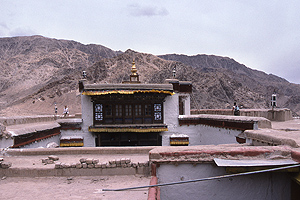
(Leh, Jammu & Kashmir, India)
I had a great deal of difficulty sleeping. Our hotel was inhabited by a couple of groups of youngish travellers and they had stayed up most of the night, until in fact the owner got up and told them to be quiet. Whether it was this, our afternoon nap, jet lag or the altitude i could not get to sleep until the small hours. We ended up sleeping until around 0900 and when we opened the curtains the sun was shining brightly outside and glinting off the Stupa 300m above us.
After breakfast we set out on our first mission of the day which was to try and find out how we could go trekking. We had gone to see an agency the night before but had been told that there was a huge film shoot going on which had absorbed all the horses and ponies in the area. This would make trekking very difficult as most long treks would require some animals. We went to another agency this morning but were met with a pretty apathetic response - maybe other people would turn up who wanted to go trekking and maybe some ponies might free us - it did not look good.
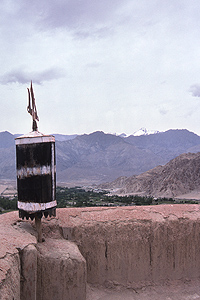
(Leh, Jammu & Kashmir, India)
Anyway we had a few days of acclimatising to do before considering trekking and by a stroke of luck we had arrived at festival time for Phyang Monastery in a neighbouring side valley of the Indus 17km away. We found a minibus at the bus station which was crowded with westerners and set off.
The ride took a bout an hour, first driving past an endless series of military bases to the floor of the Indus valley, then driving along the valley and then back up another valley parallel to Leh's. Once again the small community of Phyang was an oasis in the middle of a lunar landscape. A meltwater river from the mountains had been diverted to irrigate a series of fields occupying the whole of the side valley. Interestingly the monastery and the majority of the village were built on top of a moraine. So valuable was every square centimetre of irrigable land that nothing had been wasted on houses.
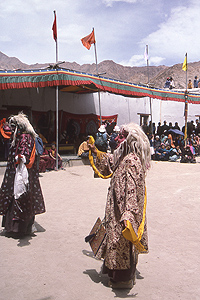
(Leh, Jammu & Kashmir, India)
Walking around inside the monastery we found that although outside had been thronged with tourists most of them were outside watching the music. We climbed all the way to the top of the monastery and from there took in the panoramic view of the valley. Back inside we took a look at some of the shrines, these had a certain charming simplicity because although they were very colourful they were not encrusted with gold and jewels. Lacking a guide we had to work out for ourselves what rooms did. At least one resembled a library with huge walls of brick like dusty tomes.
Finally we went back outside to see the focal point of the ceremony, the singing and dancing. In a square below the monastery a 10m high Thangka had been unravelled against the side of the building. The square was packed with Ladakhis dressed up in their finery. An equal number of tourists drifted around, an alarming number having foot long apo lenses which they delighted in thrusting into the faces of somewhat bemused Ladakhis. The dance consisted of four monks with leather face masks walking around in a circle in the centre of the square. What was more interesting was their accompaniment, a small army of saffron clad monks playing a variety of instruments from symbols to long silver trumpets.
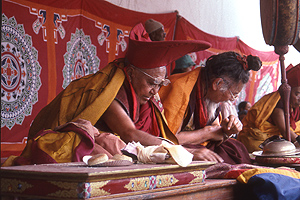
(Leh, Jammu & Kashmir, India)
After a while all this finished and two of the more important monks started chanting. It would have been fairly serene had it not been for the tourists, one of whom snuck up behind the stage where the chanters were and was videoing them from a standing position as if they were under a microscope. It started making me feel a bit sick as if what had once been a fairly meaningful religious event had turned into a glorified photo opportunity. I was not sure how the locals felt about it as most of them seemed to revel in the attention. One thing we did know was tourism was a vital part of the Ladakhi economy so for bad or for good they had to put up with it.
We decided to leave and headed off along the moraine on which the monastery was sited to see what we could see. We decided to drop down to the valley floor and try to find the river which irrigated the valley. This proved very difficult as every square inch of land was crammed with crops. After a few twists and turns and some pointers from the locals we got to the river which turned out to be no more than a couple of metres wide. I was forced to conclude that the irrigation was so successful that there was very little water left to flow into the Indus.
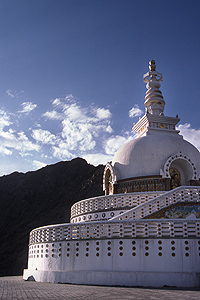
(Leh, Jammu & Kashmir, India)
We walked back up some concrete stairs and through the small village perched on the side of the moraine and back to the monastery. It had been very peaceful in the fields and the return to the noise and bustle was not appreciated. We skirted the main throng and returned to the road on which the buses were parked. After a very crowded bus ride we got back to Leh, There we walked up through the town back to Changspa and on a whim, I wanted to catch the sunset, we started climbing the stairs to Shanti Stupa the gleaming white monument above our hotel.
Very quickly we realised quite how un acclimatised we were, we had to stop frequently and at one point when Anna questioned whether we should give up I was sorely tempted to cave in. Thankfully the English resolve kicked in and we made it all the way to the top. The view was spectacular and the sound of chanting from the small monastery served as an excellent accompaniment. We stayed for a while enjoying the panorama over Leh and watching the shadows steadily grow. Bizarrely just as we left a large contingent of Japanese tourists, replete with the longest lenses know to man and the most industrial looking tripods, gasped to the top of the stairs. I was very unsurprised to recognise one of them from Phyang - he was unmistakable as he had three separate camera bodies with lenses of different focal lengths slung round his neck and (I swear) a set of kneepads.
Back down in the town we had a not very pleasant meal which was not enhanced by the fact that again we were freezing cold. Despite temperatures in the mid twenties, blue skies and a scorching sun, we would have to wear our fleeces every night to ward off the cold.
Tuesday, 20 July 2004
Leh, Jammu & Kashmir, India
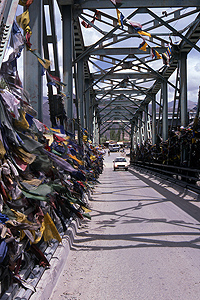
(Leh, Jammu & Kashmir, India)
We had met Matt and Claudia at the airport. Like us they had come in on the BA flight and had to wait half the night for the flight to Leh. We had got talking to them in the domestic departure lounge and had found and that they were both teachers and were on pretty much the same itinerary as us. We had run into them briefly on Sunday and had been with them to see the trekking agency where we were told about the filming. We had agreed back then to search separately and to get together at 0900 on the Tuesday at the "Tibetan Kitchen" for breakfast to compare notes.
It took us a while to find them as there were about five Tibetan kitchens. However fortunately the centre of Leh is laid out such that two sets of people searching for other will inevitably run into each other. We sat down and had breakfast and discussed the same sad story, a general lack of trekking parties and ponies. However Matt and Claudia had found an agency with a couple of people interested in doing the trek I wanted to do, the somewhat mysteriously named "Hidden Valleys of Ladakh" trek. Although they had wanted to do another route they had to compromise as the options were practically nil.
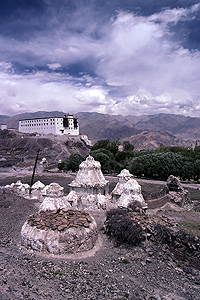
(Stok, Jammu & Kashmir, India)
So after our dumplings we went down to the agency and started chatting to the guy running it. However we were interrupted when, by the usual coincidences that happen when you are travelling, the other two people turned up at the agency to see what the status was, a couple of AMerican girls Melissa and Emily. We were a bit dubious about some of the arrangements, they told us we would be using porters rather than ponies, but nevertheless arranged to regroup at 1800 to make the final arrangements and talk to the guide.
After this bit of good luck we thought we would spend the rest of the day at a village called Stok . We were a bit late so decided that rather than go by buses we would try our hand at a taxi. This turned out to be fantastically easy as all the taxi prices in Leh were tightly controlled and we were given a fixed price for the return trip plus waiting time so had no need to haggle. The journey to Stok was fairly dramatic, we descended again to the Indus, crossed a bridge completely covered in prayer flags and then re ascended to Stok's side valley. As we ascended the snow capped peak of Stok Kangri rose above us. the taxi driver dropped us at Stok palace. This turned out to have been the residence Royal family of Ladakh ever since they were kicked out of the palace at Leh in the 1940's. It was a huge white Tibetan building again on a moraine looking out over the Indus plain. Instead of going straight into the palace we decided to first walk up the Stok valley in search of the monastery.
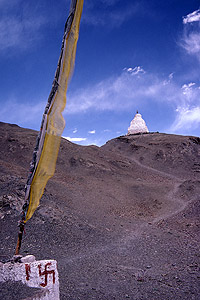
(Stok, Jammu & Kashmir, India)
The walk was incredibly pleasant. We assumed the majority of Stok's population must have been at the Phyang festival as the village was completely empty as we walked through the fields. When we got to the monastery that too was completely empty. We walked around the deserted passages, exited the other side and continued up the valley for another half an hour. Here we met the only person we saw in Stok and Anna had a bash at speaking to him in Ladakhi.
On the way back we climbed up to a Chorten high above the monastery and then descended back towards the palace. Inside the palace we were able to see a few of the rooms as well as take a look at the Ladakhi crown jewels. However it had been the walk through the fields which had been the star of Stok and we climbed back in the taxi and worked our way back across the plain towards Le with a sense of satisfaction.
Back in Leh we had a late lunch on top of a building in the central square before meeting up with the others and our guide. Here we had some more good news, Emily amd Melissa had found another agency with some horses and had somehow persuaded them to lend them to our company, thus no need for human porters. After this we went for dinner at another Tibetan kitchen. Here all the dumplings were made freshly resulting in over an hours wait, however it was well worth it. We followed this up with our first full nights sleep, finally we were acclimatising!
Wednesday, 21 July 2004
Lamayuru, Jammu & Kashmir, India
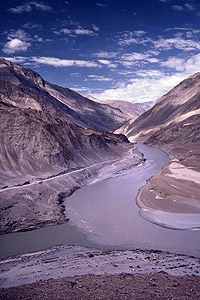
(Kargil Road, Jammu & Kashmir, India)
We got to the travel agency at 0720 but no-one was there so we went for breakfast at a bakery around the corner. Whilst I was having some very indulgent apple pie Matt and Claudia turned up. I finished up and went to check on the loading of the jeep which was when I noticed something a bit odd - there was only one smallish jeep for six large westerners plus guide, cook and driver. We discussed it with the guide but he seemed relatively confident that we would all fit in. This proved difficult but not impossible four on the back seat, two next to the driver and the guide and cook behind the back seat with the luggage!! In the end the trip was uncomfortable but not unbearable. the two AMericans were travelling on a budget so had negotiated a very competitive rate, thus the corner cutting had to be expected. Besides which it gave us a chance to get to know each other that being split across two jeeps would not have allowed.
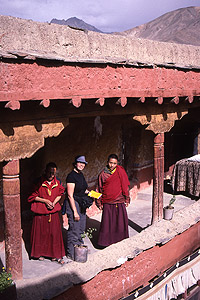
(Lamayuru, Jammu & Kashmir, India)
I will gloss over how jaw dropping the scenery was travelling down the Indus valley and fast forward to our first stop at Alchi . Here there were a group of temples built by the translator Rinchen Zangpo in the 10th century which were highly decorated with some of the most intricate frescoes to survive to today. I would like to say I was impressed by them however they were in a poor state of repair with some water damage and were not on the scale of some of the more contemporary efforts we had seen so far at monasteries.
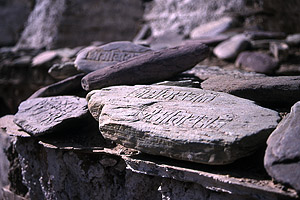
(Lamayuru, Jammu & Kashmir, India)
After this the next stop was Lamayuru a monastery quite a way off the Leh-Kargil road 150km west of Leh, where we would start our trek. The approach to the monastery was spectacular, the road winds up a tiny river gorge which suddenly opens out to a small plain high above which the monastery sits on a rocky outcrop. We enjoyed the approach but when we got to the campsite it was a different picture. It looked like a scene from Glastonbury with hundreds (well probably not) of tents dotted around a set of small terraces. We found a good spot, set up the tents and went to explore.
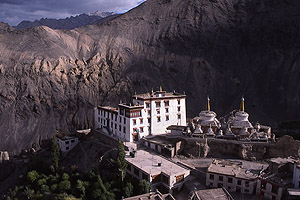
(Lamayuru, Jammu & Kashmir, India)
After a short steep walk up a hill we found the entrance to the monastery and went in, Inside was a small open courtyard with a variety of intriguing but locked doors. Anna and I climbed up a level and found ourselves on the roof with yet another breathtaking panoramic view. Pretty soon the others joined us and whilst we were standing there a young monk popped his head out of a window. We chatted to him and after a while he agreed to let us have a look around. By far the most interesting room was the main prayer hall. Rows of benches crossed the room, the sides of which were dotted with niches contain the square brick shaped prayer books we had already seen. At the front of the prayer hall was another small room, presumably to allow the Rinpoche to lead the prayer from, with various statues and religious knick knacks. We asked the monk questions and he did his best to answer in surprising clear English. We were also shown around another room which contained what looked like representations of Chortens clad in gold and silver.
After the monastery we climbed the hill behind the monastery to a Chorten adorned with streamers of Thangkas. From this point we had an outstanding view of the monastery in the setting sun. Then we went back to the campsite to have an excellent dinner followed by an even more excellent night of sleep.
Thursday, 22 July 2004
Wan-La, Jammu & Kashmir, India
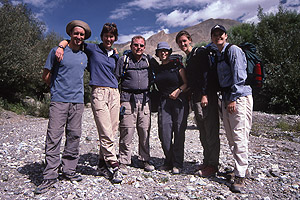
(Lamayuru, Jammu & Kashmir, India)
We got up pretty early however the process of readying the mules and packing up took a lot longer than anticipated. In the end we set off at about 0900 back down the valley and then climbing up a side valley. The going was very hot and the prevailing terrain was again lunar with dry, grey dust. After a while we started climbing steeply up towards Prinkiti La Pass at 3650m. At the top, knackered, we stopped for a rest before quickly descending the other side.
Over the pass we were in the first of the so called "Hidden Valleys" of the walk. However it was not exceptionally well hidden as a rough road had been run to Wan-La, where we were to spend the night. Down on the floor of the valley we found ourselves walking along a pleasant stream and stopped for some lunch by its side. We stayed for a while occupying ourselves by dunking our heads into the glacial water and playing pooh sticks. From here it was literally twenty minutes to the campsite, a pretty dusty field by the side of a river.By the time we started setting up camp it was 1400.
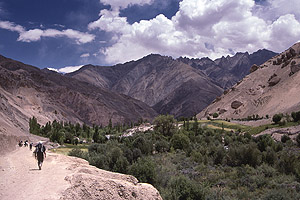
(Wan-La, Jammu & Kashmir, India)
After everything was set up and we had chilled for a bit in the sun we set off to explore Wan-La's monastery, again dramatically situated on a rocky spur 100m above us. It was an okay but still quite tiring climb given the altitude but eventually we reached the top. It turned out that the only bit of the monastery open was the temple which contained some statues. However the structure was quite literally falling apart and had only just about been rescued by a team of Swiss archaeologists using two by four to prop up the bowing walls. Whilst Anna was again chatting to one of the monks we decided to climb further up the spur the monastery was on, however the shale made for very loose footing so we had to stop after a while.
We decided to return by dropping down to the other side of the spur to a small side valley and then walking down that to the Leh to Wan-La road. This was by far the most interesting part of the afternoon's excursion as the village was pretty much untouched by tourism. We also deduced the purpose of a custom which had been catching our eyes for a while. Around every young tree Ladakhis had put a tube of tin cans one on top of the other presumably starting from when they were saplings. We had thought it was to stop animals chewing them however we realised that they were designed to ensure the trees grew straight despite the winds. Every house in Ladakh is made of wood so it was vital that they had straight beams of wood for the intricately carved doorframes and windows.
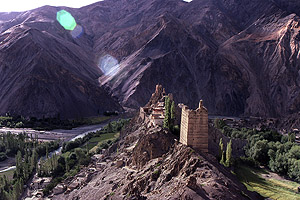
(Wan-La, Jammu & Kashmir, India)
Back at camp we had a short rest and yet another excellent meal followed by a few games of "Pass the Pigs" which Matt had bought along. Pretty soon the light started failing so Matt, Claudia and us had to retreat to a tarpaulin and light bulb at one end of the campsite that doubled as the local bar. Just before the four of us went to bed we decided to brave the toilets en masse. To understand why this was safety in numbers it is important to realise that it was little more than a raised shack with a hole in the floor and a piece of sacking as a door. That night there was a stiff breeze which created two comical effects for Matt, who went first. Number one the "door" of the toilet kept flying open; number two there was an up draught through the hole which meant that as soon as Matt went to put some toilet paper through it flew back up in the air and circled the shack. Naturally Matt was somewhat put out by this and the sight of him with swearing, trying to catch flying toilet paper with his head torch bobbing around was enough to have the other three of us in tears of laughter.
Friday, 23 July 2004
Hinju, Jammu & Kashmir, India
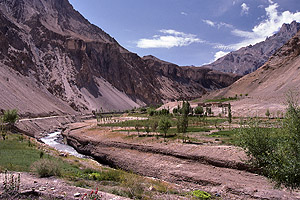
(Hinju, Jammu & Kashmir, India)
We got up relatively early and set off to camp in a place called Hinju. This involved a not very strenuous trek up the river on which Wan-La was sited. The first part of the trek was along a road to a place called Phanjilla. Fortunately here the road split and seven of the groups that had been camping at Wan-La turned south to trek to Padum in the Zansker valley (a ten day trek).
Funnily enough in Phanjilla we met someone who lived in Islington. It appeared that two girls from London were in a group of their own and had decided to set off before their guide who had given them instructions on how to get to Phanjilla. Unfortunately the guide had some issues with left and right so the girls spent an hour walking in the wrong direction before a friendly villager put them on the right path. By the time we caught up with them just outside Phanjilla they were both pretty annoyed so we invited them to have a cup of tea with us when we got there.
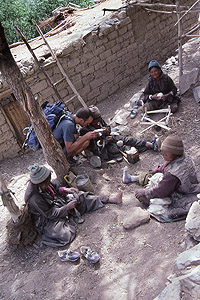
(Hinju, Jammu & Kashmir, India)
Although it sounds a bit odd its not unusual for a guide to disappear when the going is straightforward. Our own guide Lobzan seemed to spend no more than ten minutes with us every day. Generally he was well ahead of us which was understandable as he had to help set up camp. He would almost always be waiting for us at any forks in the track, and sure enough he was waiting for us at Phanjilla. However the girl's guide was nowhere to be seen. They concluded that their guide had gone on ahead of them, the last time we saw them they were in the cafe preparing to set off down the Zansker valley sans guide to catch up with them.
We stopped for lunch at a very peaceful spot by a stream. We again dunked our heads in the stream but sadly did not have the scope for pooh sticks. The afternoon's walking, although not strenuous, seemed endless. We carried on up and up the valley to Hinju, where we found some women spinning wool, and up into the fields beyond. After a while the fields started to run out and it was here, just as we started loosing all hope that we spotted our camp.
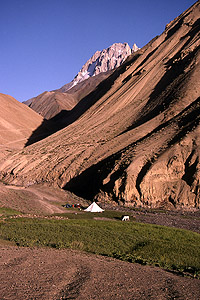
(Hinju, Jammu & Kashmir, India)
To say the spot was stunning is an understatement. We had been getting a bit distressed at earlier sites as they seemed almost like municipal camp sites, not at all the wilderness experience we had come on this trek for. However finally on our third night of camping we were truly in the wilderness. Above us was a towering peak whose North face was covered by a 200m wall of snow. Because the valley snaked to and fro we could not see the other two groups camping ahead of us so the effect was unbeatable. After putting up the tent I dashed into the river for a much needed bath. As it was glacial meltwater it was very, very cold but once you were out and dry you felt much better for the experience.
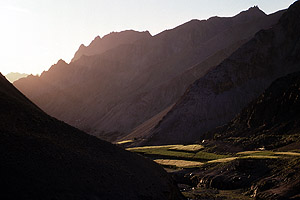
(Hinju, Jammu & Kashmir, India)
Dinner was a very warming Tibetan soup known as Thenthuk which consisted of vegetables and pieces of pasta. It was so filling we only managed to force down two portions and then had to quit. We stayed up for a while after this playing "Pass the Pigs" with the guides, much to their amusement, before turning in.
Saturday, 24 July 2004
Kongze-La, Jammu & Kashmir, India
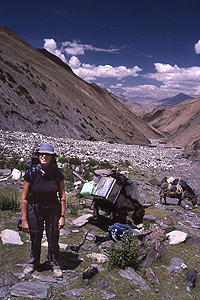
(Kongze-La, Jammu & Kashmir, India)
This was to be the hardest day of the trek. We has to ascend from our camp at 4600m to the Kongze-La pass at 4950m. To say the climb was difficult is to understate facts dramatically. As we went up the air got thinner, the air thinner and the path steeper. Anna and I struggled and at more than a couple of places I thought I would collapse with exhaustion. However when we finally crawled to the top it was all worth it - the view was spectacular. The arrangement of prayer flags and sheep skulls was very photogenic and we knew that we had reached the highest point of the trek.
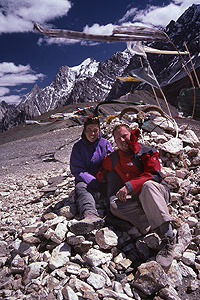
(Kongze-La, Jammu & Kashmir, India)
The others, being a bit fitter than us, had reached the top ahead of us. So we sat down and had lunch with them before descending. The path was very steep at first bit rapidly transformed into a difficult slog along a bolder strewn river bed. We had to cross the stream in two or three places and a lot of time it was not exactly clear where the path went. Lobsan as usual was well ahead of us so there was no-one to ask how far we had to go. At every turn of the river where we thought we would find the camp we found nothing and had to slog on.
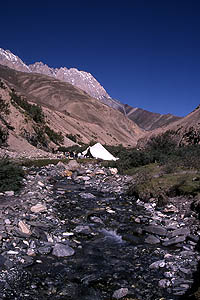
(Kongze-La, Jammu & Kashmir, India)
When we finally found it the spot was again exquisite. It was very late so we had little time to enjoy it before the sum started to drop behind the mountains. I however used the time to get another icy bath in. Dinner was yet another curry but this time with pulses that filled me up so much I was unable to finish. After this was the now obligatory game of "Pass the Pigs" with our addicted guides and then to bed.
Sunday, 25 July 2004
Dung-Dung La, Jammu & Kashmir, India
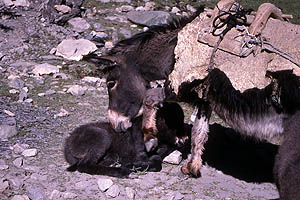
(Kongze-La, Jammu & Kashmir, India)
The night was eventful, but before I describe what happened I must explain something about our animal accompaniment. We had two horses and six donkeys out of which three started out with foals (it was that time of year) and two were pregnant. To the western eye this may seem a bit harsh however I guess for the locals it is a fact of life - they do not stop using animals just because they are pregnant. Anyway in the night the most heavily pregnant donkey gave birth and when we woke up it was already tentatively walking around by the guides tent.
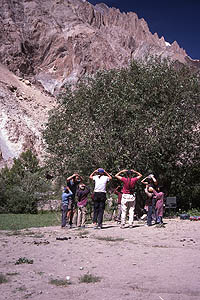
(Sumdo, Jammu & Kashmir, India)
Anyway we had breakfast and we packed everything up, including the new born donkey who was simply strapped to the side of its mother with a jerry can of petrol counter balancing it. The start of the walk was relatively easy. After a while we reached the village of Sumdo Chinmu where we found a small square in which seven several children sitting in a row reciting English. Immediately the three teachers in our group, Matt, Claudia and Anna leapt on the children and started helping them. Meanwhile I went to check on the teacher who was at the other end of the square in a small forge with another man manufacturing spoons to sell to tourists. After chatting to them I returned to the teachers, who by then were on a singing lesson teaching them "Heads, Shoulders, Knees and Toes" and about to move onto "Hokey, cokey".
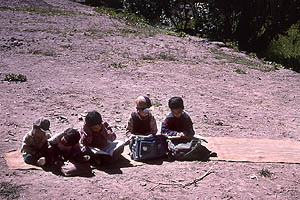
(Sumdo, Jammu & Kashmir, India)
After a while we finally had a short walk along a river then again found ourselves facing a huge pass. At (what we thought was) the Dung-Dung-La pass was a lot easier than the day before. We slowly trudged up it and then had lunch at the top. After this we slowly went down to a long traverse after which we were very surprised to find the camp site.
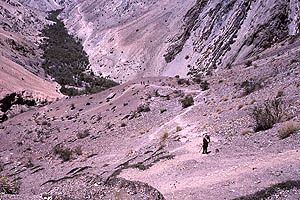
(Dung-Dung La, Jammu & Kashmir, India)
This camp site was again very remote but this time the stream was a tiny trickle and the other two groups had seized the prime camping spots. However not wanting to be discouraged we searched around and found and amazing camping spot, a small terrace overlooking the valley below.
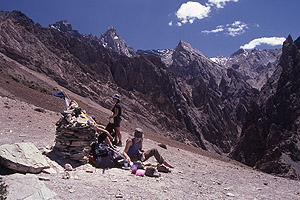
(Dung-Dung La, Jammu & Kashmir, India)
When we arrived it was 1430 so after we had put the tents up we had a lot of time on our hands. Anna and I walked up the small stream to the last tree on the stream and sat there writing our diaries and reading. About 1800 we walked back and got ready for dinner. Again it was excellent, some sort of non fired pakora which they called tomato Manchurian and a pea and paneer dish.
Monday, 26 July 2004
Chiling, Jammu & Kashmir, India
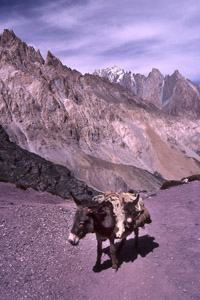
(Chiling, Jammu & Kashmir, India)
We got up at 0530 in order to make an early start so we could get back to Leh the same day. The first part of the trek was up the valley we had been camped in. This had been puzzling us since we had been told the pass we had crossed the day before was Dung-Dung La. However it rapidly became apparent that what we were faced with was in fact this pass at 4820m. Fortunately however it was not too much of a climb and after a couple of hours we were sitting on the top with a glorious panoramic view.
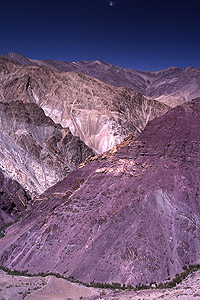
(Chiling, Jammu & Kashmir, India)
After this it was a tortuous descent. First we did a long traverse which took us to another saddle, then it was down hill all the way. The scenery was barren yet stunning - harsh rock in a variety of different colours - yellow, red and even a vivid green. However the lack ok of vegetation meant that it was blisteringly host. After roughly two hours we found ourselves in a river canyon and stopped for lunch at a small pool which one person was just about able to fit into. Both Matt and I had a quick plunge in the pool. Further on down the canyon we found a number of very inviting pools and water slides cut into the solid rock.
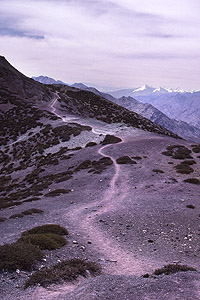
(Chiling, Jammu & Kashmir, India)
The canyon, although beautiful, seemed endless but finally we found a Chorten and reached the outskirts of Chiling. Unfortunately once there we were to find a rather bitter surprise. There were two jeeps waiting at the banks of the Zansker river, however both of them were for one of the other groups - three Swiss women. We were told by our guide that our jeep was going to be half an hour late so we went around the corner to see the local spectacle. Here a wire crossed the raging torrent of the Zansker and suspended from it was a small cage which the remaining group, on a much longer trek, were using to cross the river.
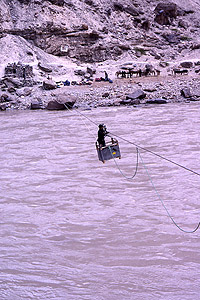
(Chiling, Jammu & Kashmir, India)
When we got back the situation had not changed. I eventually asked the guide what he was going to do about it - he and the cook were engrossed in Karom a local game that looked like a cross between snooker and tiddlewinks. After a bit of discussion they both set off down the road towards the Leh-Kargil road. We were not to see them again that night. We sat, talked, played Karom and skimmed stones across the torrent of the Zansker. By eight no-one had turned up so we decided that as the light was failing we should put our tents up. There was a nice campsite at the back of the restaurant/shop we had been waiting on. It had several tiers and was dotted with apricot trees. We raided the left over trekking supplies and found some pasta and tomato sauce which we had for dinner and then went to sleep.
Tuesday, 27 July 2004
Leh, Jammu & Kashmir, India
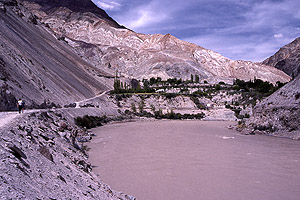
(Leh, Jammu & Kashmir, India)
During the night there had been developments. Apparently the owner of the travel agency had waited until 2200 for our return and when we had not turned up had found another jeep driver and set out into the night. The driver found it hard to stay awake, nevertheless they had arrived at 0200. Matt and Claudia had heard them and went out to tell them what happened. They had decided that the jeep driver needed some rest so had let everyone sleep on whilst the jeep sriver slept the night in the jeep. We woke up at 0530 and immediately packed and set off for Leh.
Coming back to Leh was a bit of a culture shock. The streets were thronged with hippies with their Enfield motorcycles fleeing from the rainy season in Goa and hawkers selling everything from pashminas to fake antiques. We went back to the hotel we had been staying before, dragging Matt and Claudia with us. Dumped our stuff, had a shower then went back into town to pay the balance of our trek. After this we went to visit the "Women's Alliance for Ladakh", a project set up by Helena Nordberg-Hodge. Helena had first visited Ladakh in the early eighties and concerned about the effects westernisation was having set up several projects to try to decrease its impact. The first of these was an ecology centre to advise local farmers on the best agricultural products, pesticides etc., to use as the West had begun dumping products banned in their countries pon the developing world. This had proved a great success but Helena had noticed that women were being sidelined in the process. So she had set up the Women's alliance to redress the balance.
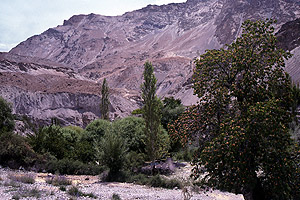
(Leh, Jammu & Kashmir, India)
The main thing that the Women's Alliance was doing at the moment was trying to educate tourists. Every day at three they show the video "Ancient Futures" a documentary about the effect of modernisation on Ladakh. It was very informative especially about the Ladakhi society used to operate. However we could not understand how the WA was seeking to change what was happening except through education. We had a short question and answers session at which I asked about employment opportunities for local people. the video had suggested that, as with most developing cultures, there was a trend away from the country to the cities. However I could not see where they were going as Leh was not exactly a thriving metropolis with lots of factories and offices. It turned out that apart from the army, which employs 1 in 4 Ladakhi men, the only real industry was tourism. Thus tourism was predictably destroying the unique culture that everyone had come to see.
Although the Women's Alliance were doing their best I could not help thinking that such NGOs in a way ease the conscious of Western travellers. The implication was clear, the only way to preserve the old culture was to deny Ladakh the only alternative industry, tourism. This approach has been attempted in Bhutan, a very similar culture, where the Oxbridge educated king closed its borders to independent travel and banned television. However it seems a bit hypocritical to keep a people insulated from the Western world because you have been there and decide for yourself that your people are happier.
I think the only option you have is to expose cultures to the West and give them a chance to make an educated choice about what they adopt. This is what the Women's Alliance was trying to do but like a few people in the audience I was not sure it was working. As someone else (who was working for another NGO) pointed out there was little uptake in the younger generations. As the film had pointed out the critical audience is teenage boys and girls, if you can get them to realise that life as a travel agent or guide is less satisfying than being a farmer then you would potentially stop the rot.
After this we went back to our hotel and packed, then went for a farewell dinner with the other members of the group. We were due to leave for Manali in the morning and the American girls were leaving for Delhi.
Wednesday, 28 July 2004
Baralacha La, Jammu & Kashmir, India
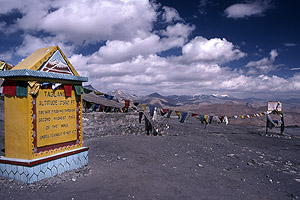
(Tanglang-La, Jammu & Kashmir, India)
We had to wake up at 0345 as our bus was due to leave from the centre of town at 0430. We had borrowed an alarm clock form the hotel owner (it was his personal alarm clock!) and just about managed to drag ourselves out of bed. The exercise was made easier by the fact that we were not in the midst of one of Leh's regular power cuts. In the town's central square we could just about make out one other person in the gloom. He was waiting for the bus and as we waited more half asleep backpacked westerners lumbered out of the night. Eventually the bus turned up and people started loading up.
The journey started off by following the road to the east end of the Ladakh valley. I sort of regretted not visiting more of the monasteries near Leh like Thikse and Hemis however we had visited four and were not in the mood for more monastery bagging. I remembered when we had been to Bali nine years before we had bagged as many temples as we could in a week and we had just ended up feeling pretty ambivalent.
The bus slowly climbed up and up to the Leh to Manali Road's highest (and India's second highest) pass the Tanglang-La. At 5359m the view was quite spectacular, however quite a few vehicles had stopped there leaving their engines on, so with the thinness of the air it soon became very polluted. On the subject of pollution there was a minor war already brewing on the bus, the passengers consisted of nine Israelis, two Swiss french, a Spanish cyclist, a young English girl and us. Out of the Israelis there were a couple of girls who started to smoke at the back of the bus. This annoyed pretty much everyone and after a heated exchange in Hebrew it was decided that the bus would be non-smoking.
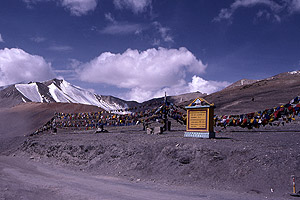
(Tanglang-La, Jammu & Kashmir, India)
After the pass we descended to the Moray Plains, kilometre after kilometre of mountains and uninhabited sparse grasslands. After this we descended into a dry deep canyon which we followed for a long time slowly climbing upwards until we reached the top of Lachuglang La pass (5020m) where we skirted the nose of a glacier.
After this we descended into Sarchu Serai, another dusty plain bifurcated by a huge river canyon whose spurs required several detours as the maximum bridge span for army bridges was 30m. At the end of this was a large number of tent encampments used as overnight stops on the trip. Our bus however was to press on and we slowly ascended up to what, for us, was the most spectacular pass the Baralacha La .
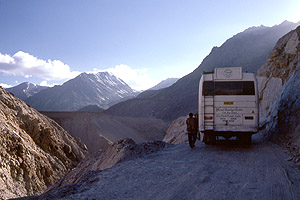
(Baralacha La, Jammu & Kashmir, India)
The approach to the pass was over a glacial plain. Above us towered a huge mountain which had been worn carved away by eons of glacial erosion. Around us on the plain were strewn thousands of blocks of rock ranging from the size of a television set to almost house sized. At a stop we noticed some movement in the blocks and caught our first sight of Himalayan Marmots which populated the area and were pretty much the only wildlife of the trip.
At this point I should explain a bit about the other traffic on the road. This consisted of one or two Tata goods trucks and hundred of Tata petrol tankers. The petrol tankers were almost exclusively driven by Sikhs up from Amara to supply fuel for the war effort in Kashmir. As an aside were the Indian government ever to want to save money they could do so by insisting that all the soldiers in Leh drive around on scooters rather than flatbed trucks. In Leh quite often you would have to jump out of the way of a truck thundering down the road only to turn around and see that the truck was empty apart from the driver. Anyway the situation with the thousands of petrol tankers required to fuel the empty trucks was not helped by the condition of the road. At best this was patchy tarmac, at worst it was nonexistent. In fact in terms of bus trips it was second only to our mammoth 50hr journey from Kashgar to Urumqi over the Taklamakan desert.
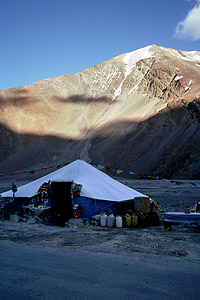
(Baralacha, Jammu & Kashmir, India)
Anyway all these factors came to head just before the Baralacha-La pass. The road narrowed to a small ledge cut into a sheer rockface 200m above a raging torrent of a glacial river forced into the very narrow canyon we shared. We suddenly turned a corner and found ourselves faced with three petrol tankers. Our driver, who was not especially mature, had a bit of a habit of playing chicken with other drivers. This time he won out against the first two and thy were forced to swerve round the outside of us - literally right on the edge. However the third river hung back and did nothing. So our driver edged forwards and for some reason took the outside and parked literally 15cm from the void. The petrol tanker came forwards and proceeded to try and fit between the bus and the rock face. As it became rapidly apparent to the passengers of the bus that the truck would not fit everyone started to panic and suddenly there was a dramatic pop as one of the windows behind us was shattered by one of the wing mirrors of the tanker! At once the bus reversed and the driver got out and proceeded to have a slanging match with the Sikh in the tanker.
Meanwhile all the panicked passengers jumped off the bus, oblivious to the fact that there was only 15cm of ledge on the door side of the bus along which they had to shuffle to get to the road behind the bus. By the time we all got round to the front of the bus a stand off between the drivers was well established. Our driver wanted 200 Rs for the broken window and the tanker driver would only pay 100. After half an hour of sitting around in freezing winds we decided that the only way to break the deadlock was to have a whip around between ourselves to collect the disputed 100 Rs (about £1). After this the bus still had to get past the tanker, which it did but with no passengers on board.
We then climbed up towards the pass again. However a little further on we reached another tent encampment and here the bus driver announced that we were not going any further that day. This came as a complete surprise to a few people who thought it was a non-stop bus. It even was a bit of a surprise for us as we thought it would go a bit further to Darcha. A little shell shocked and in a dream world us passengers were shepherded out into yurt like tents run by enterprising Tibetans. Funnily enough we ended up in one yurt with all the non-Israelis and all the Israelis were in another. We ate a pretty tasteless Thukpa soup, talked to the Swiss couple, the Spanish cyclist and the English girl. She turned out to be only 20, on her way for a course in massage at Dharamsala and quite the centre of attention for the scores of Sikh drivers also stopping off at the yurts. About nine we went to sleep under huge piles of quilts at the back of the tent, frankly glad to still be alive.
Thursday, 29 July 2004
Manali, Himachal Pradash, India
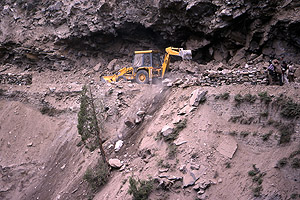
(Darcha, Himachal Pradash, India)
When the Tibetan woman running the yurt woke us up at 0530, she did not have to explain why as we could hear the bus running outside. We milled around a bit, had some tea and then jumped in the bus. However as soon as we were installed there was a great commotion, the smoking Israeli girl was telling the bus driver even though the other Israelis, who she had fallen out with the day before, were not yet up. In the end they turned up and we left.
The rest of the Baralacha La pass was dramatic in terms of scenery but fortunately there were no more interruptions or incidents. then it was straight downhill on yet another series of endless switchbacks to Darcha. This was just another jumble of Tibetan food stalls and truck stop hotels. However what was interesting was the marked change in scenery. Gone was the barren moonscape of Ladakh, it had been replaced by slopes covered with grass and quite incredibly for the first time on our trip there was a drizzle of rain. It was also the end point of a trek down South from Padum in the Zansker valley which must, I reflected, be an experience given the change in vegetation.
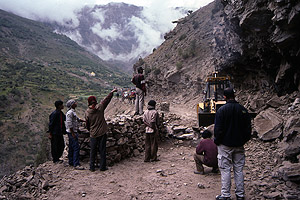
(Darcha, Himachal Pradash, India)
We then had quite an interesting trip along the valley of the river Chandra. Again we were hugging cliffs on a ledge barely wider than the bus with little in the way of tarmac. The at a point just before the town of Keylong we found a landslide blocking the road. Fortunately, by the time we reached it, it was being cleared by some people with a bulldozer who were alarmingly just pushing the rocks over the cliff edge.
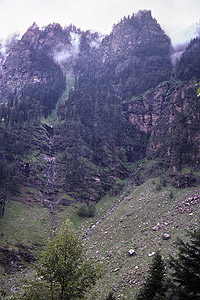
(Manali, Himachal Pradash, India)
A bit further on we stopped at Koksar where the restaurants were so horrific we did not even dare eat. We just bought some crisps and ate them whilst we were subjected to our third and final passport check. After this we climbed up to the Rohtang Pass (which literally means "piles of dead bodies" in Persian). This was a close second to the Baralacha la. We zigzagged backwards and forwards on one mountain whilst facing another mountain wreathed in cloud. This cloud clearly hid glaciers and snow capped peaks as we could see climbing its lower slopes terraced fields bisected by torrents of water. We to were in the clouds before very long and this was the downside to the Rohtang. The driver could barely see in front of him and there were several traffic jams, stand offs and many, many minutes of waiting.
Coming off the Rohtang pass was like a descent into another world. As the clouds slowly cleared we could make out huge forests of pine. These forests cover the entire area around Manali and the Kullu Valley. Soon we started to make out waterfalls and after much zigzagging we found ourselves underneath them, water quite literally spilling off rocks and plummeting 100m down to dissolve in mist, a site we have not seen since Venezuela.
Before long we were in Manali . We had assumed that Manali would be a hippy hang out of colossal proportions. However to be honest it was empty, probably because the onset of the monsoon had driven all the pot heads North to Leh. We hunted around for a hotel and found one with a fantastic room at one in the North of the city. It did not have a great view of the valley but the hotel bordered on the huge pine forest that extends north of Manali. the room was completely wood panelled and had a huge fireplace and verandah on which we could sit.
That night it started raining. It had been a very sunny day in Manali but whilst we were sitting in a Chinese restaurant downtown the heavens opened up and it proceeded all night long.
Friday, 30 July 2004
Manali, Himachal Pradash, India
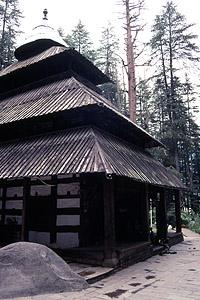
(Manali, Himachal Pradash, India)
It was undeniable that we were tired. Practically every day since the start of our Trek in Ladakh nine days ago we had woken up between 0500 and 0600. However the night before we had stayed up until 2300 (!) so with a well deserved sense of satisfaction we slept in until 0930 and had our breakfast at the hotel. Following this we walked North a bit to find the entrance to the pine forested park behind our hotel, and had a very pleasant walk into the centre of town, bypassing the Old Manali Rd and the lethal rickshaws which threaten to mow you down at every step. Walking through the forest I think Manali started to grow on me, it certainly was not as bad as its reputation had me believing.
We then checked out the shops. Manali is packed with shops selling Pashminas and wool shawls in general. We then found yet another German bakery where we had some lunch. We then dumped our stuff back at the hotel and then climbed the hill to visit the Hidimba Devi Temple. The temple was built in 1553 and is dedicated to Hidimba wife of Bhimi, and an incarnation of Kali. It is a very quaint wooden pagoda set up in the pine forests overlooking the town. Entering through a carved wooden doorway we found ourselves in a gloomy shrine containing several rocks under one of which apparently was the footprint of Vishnu.
According to our guide book the temple frequently sees the sacrifice of goats and buffaloes and the hollow which contains Vishnus footprints channels the blood into Hidimba's mouth. Clearly a bit was missed as round the back of the temple we found a large puddle of blood, which was clearly the result of a recent sacrifice.
After this the afternoon monsoon rains started to kick in so we retreated to our hotel verandah and spent the remainder of the afternoon sipping cool beers whilst watching the rain pour down.
Saturday, 31 July 2004
Manali, Himachal Pradash, India
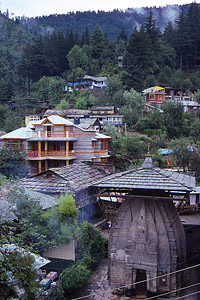
(Manali, Himachal Pradash, India)
We made a return to our usual habit of getting up early, waking up at 0700. We walked down to the bus station and jumped on a bus to Naggar a town 17km South along the Kullu valley. Because of all the looping to cross side valleys and descending via switchbacks (Naggar being quite a lot lower than Manali in altitude) the journey took around an hour.
At Naggar we thought we would find a castle but instead just found a very ordinary row of ramshackle shops. However we soon realised that the true heart of the village lay quite a way up the mountain. About 2km of switchbacks and 200m in height later we found the castle. It was quite unusual in construction seemingly more of a grandiose version of the local houses which were typically stone built with a wooden balcony/verandah circling the first floor. There was some sort of museum in the basement but it was frankly just a weird assortment of artifacts in a dingy room. The only winning aspect of the castle was its view - a panoramic sweep across the Kullu valley.
Unimpressed we decided to stop off at the small row of cafes and hotels next door for some breakfast. Rather predictably there was what claimed to be yet another "German Bakery" but turned out to be a rather poor copy. I had a piece of plum pie which was at least two days old, Anna ordered some coffee which failed to turn up.
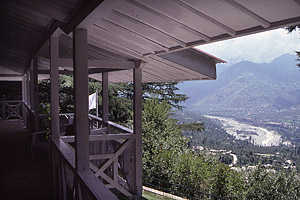
(Manali, Himachal Pradash, India)
We carried on up the hill past another attraction, which I will get back to later, and after a bit found the path to the village of Rumso. The path was very steep and the day very hot and sticky, but after a great deal of sweating we found ourselves approaching the village. The construction of the houses was amazing. Bit since visiting Dong villages in China had we seen so much wood. As far as we could tell animals and feed occupied the ground floor and the upper floor was surrounded by a wooden balcony which served to keep the inner rooms cool and provide a shady spot to sit and watch sweaty tourists coming up the hill.
I was tempted to take a photo however I had read that a lot of villagers in the valley were not impressed by westerners behaving disrespectfully and had been know to take unkindly to people taking photos or touching their buildings. When we got into the central square things we started to realise this was a wise precaution. In most villages in India people will very quickly say hello to you, here they completely ignored us. I started getting worried about things and my fears were not helped by three bubbling, human size, cauldrons in one corner of the central square. Anna however was immune and plonked herself in the middle of the square and eventually a few villagers came over to talk to her.
Apparently they were going to have a village celebration and were cooking rice and porridge in the cauldrons. As appetising as it sounded we still did not like the vibe in the village so we decided to go. Maybe we missed an opportunity however considering the constant stream of visitors to Manali since the seventies (when the Beatles popularised the area as a Hippy Mecca) it was understandable that they would be a bit distrustful of visitors so we decided that we would leave them to it.
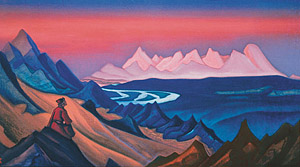
(Manali, Himachal Pradash, India)
Back down the hill again we visited Naggar's other attraction, the Roerich Institute. As far as I understood Nicholas Roerich was a Russian painter and all round scholar who lived from 1874 to 1947. After establishing himself as a painter of religious scenes (which resembled bizarre icons) he became obsessed with the Himalayas and moved his family to Naggar and started painting mountain scenes as well as collecting the local and folk art of the region. It appears that some may have perceived him as a spy because he launched several expeditions through the Himalayas in the 1920s, the time of the Great Game when Britain, China and Russia were all vying to expand their territories.
Anyway we had a look at the paintings and had a look at the house, which was beautiful. Then we had to climb up the hill again to look at the folk museum which was yet another dusty collection of artifacts gathered from all over the region from Kullu to Siberia,
After we came back we again chilled out on our balcony and watched the rain whilst having an afternoon beer, We then went for dinner going back to two days before - a welcome break from Tibetan food which, although we had enjoyed it, had been wearing on us a bit.
Sunday, 1 August 2004
Manali, Himachal Pradash, India
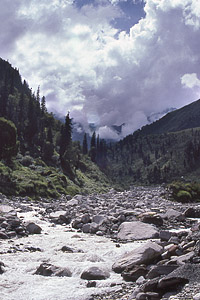
(Manali, Himachal Pradash, India)
We were meant to get going early but we overslept. Then at breakfast we found out that although we had said to the hotel we were staying three or four nights they had taken this to mean three and had booked out our room. This was our fault really as we should have confirmed when we knew when we were getting the bus back to Delhi. Anyway apart from wasting an hour of our morning it all worked out for the best as the hot water in our room had stopped working and the hotel we moved to, over the other side of the road, was even more comfortable.
A little later than planned we set off for a walk. Facing a long wait for the bus we grabbed a taxi to Palchan at the head of the Solang Valley 17km North of Manali. From Palchan we walked to Solang which for some reason is considered to be a ski resort despite only having one green run and a chair lift. It being summer there was no snow and the ski lodge seemed to be hosting some sort of mini fair. Indians had come from miles around and were picnicking on the ski slope (that's how flat it was). We walked up the slope and continued walking along a path in the hills.
The path was very overgrown and after a while we realised why. The Border Roads Organisation was building a new road along the valley which, if we understood, was going to become a replacement for the all too popular Rohtang pass. There was even mention of a tunnel on some of the signage. After struggling along overgrown pathways for half an hour we finally caved in and switched to walking along the road. This was not as easy as it sounds, it was very muddy in some places and in others the bank had only just been cut away and a landslide was a very real concern.
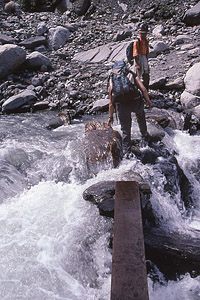
(Manali, Himachal Pradash, India)
Nevertheless the scenery was excellent, around us mountains were covered with huge Deodar Cedaers interspersed with high alpine meadows and spectacular waterfalls. We had a couple of river crossings including a very dramatic one which involved a shaky log bridge, a plank of wood and a couple of stepping stones submerged in a raging torrent. Finally we got to Dhundi and there stopped for a coke at a tiny cafe set up for the large encampment of workers. Sadly here we were forced to turn back to Manali because of time. This was a shame as further up the Beas River (which flows through the Solang down to Manali) we could see huge glaciers and from our map we knew there was a glacial lake.
Back at Palchan we were in for a bit of a shock. When we had been dropped off there were plenty of taxis and rickshaws hanging around, now there were none. From the looks of it everyone in the town was involved in a rather strange ceremony on the other side of the river, chanting and dancing. We started to panic a bit but finally decided to start walking back towards Manali. Fortunately a taxi turned up after fifteen minutes or so, if it had not we would have had four hours walk back in the, just started, monsoon rain,
That night we finally broke the £10 barrier for our dinner and ate at a nice Indian restaurant called Khyber which made a decent cocktail an excellent food. We stuffed ourselves stupid but as it was technically our last meal in India (the next evening being consumed by getting back to Delhi) we felt we deserved it.
Sunday, 1 August 2004
Delhi, India
The next morning was shopping. Anna had been hankering after a Tibetan Singing Bowl and Manali was a bit more of a relaxed shopping experience than Leh. Then in the afternoon we caught the night bus to Delhi. This proved a much less traumatic experience than the Leh to Manali bus. We stopped once at a bus stop in Shimla but could not make out much in the black of the night.
Monday, 2 August 2004
Delhi, India
We got into Delhi the next morning. Since we had a few hours to kill and did not have a hotel we decided to drop our bags at the airport and then go for a look around. It was a fairly hot and humid day and we had not slept well so did not have a huge desire to run around looking at everything so we decided to go to the National Museum. It turned out to be a good choice, not only because it had a fairly good collection of old things but also because once we got inside the heavens opened up and we were effectively stuck in it. At one point it was raining so hard water was dribbling in through the windows of the somewhat elderly museum prompting much running around.
And that was it, we hopped on the plane back to the UK later on that evening. It had been an excellent trip to India (our second that year) and yet again the sheer scale and variety of the Himalayas had impressed us,





